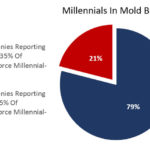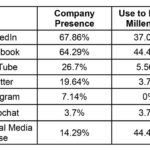By Rachael Pfenninger, Project Manager
AMBA
Like many segments of the manufacturing industry, workforce development continues to plague American mold builders. According to the National Association of Manufacturers, in Indiana alone, 87% of manufacturers indicate difficulty in recruiting youth. At the same time, according to a recent Deloitte Insights report, more than half of the potential two million jobs that will become available over the next decade in manufacturing will likely go unfilled due to a skills shortage.
To help combat this epidemic, the American Mold Builders Association (AMBA) recently published a study titled, “Best Practices for Recruiting the Millennial.” The report, which includes survey data from 56 mold builders across 17 US states, details best practices and actionable items related to recruiting, retaining and motivating the millennial worker. For the purpose of this study, a millennial is defined as someone born between 1987 and 2000.
Changing the demographics of mold building
Although the majority of mold manufacturers employ some millennial-aged employees, responses indicated that 79% of US mold builders operate facilities where approximately one-third or less of their employees are millennial-aged.
In an article titled “Workforce Gap Grows as Boomers Retire,” Brian Forney, global business manager for Training Services, argues that the mold building industry skews toward an older demographic because high school students – and their guidance counselors – associate manufacturing with dark and dangerous plants that are low-tech, limited opportunity facilities.
Actionable Tip: When recruiting millennial-aged employees, manufacturers should first address the preconceived ideas educators and students have about jobs in manufacturing by building relationships with and providing education to local guidance counselors, high schools, technology centers and technical schools.
Millennial recruitment messaging and strategy
Despite the tendency to skew toward an older demographic, mold builders did name several best practices in millennial recruitment. For instance, 87% utilize both technical schools and employee, friend and/or family referrals, while more than half build relationships with high schools and post jobs on recruiting sites, such as Indeed.com and Ziprecruiter.com.
It is worth noting that although only 5% of respondents use newspapers or radio to recruit millennials, traditional media should not be disregarded as a recruitment tool. Recent research at Bangor University demonstrated that touching printed materials can actually have a more personal effect on the millennial generation and can be particularly effective when combined with other forms of messaging (digital or otherwise).
Actionable tip: Think about using a tiered approach when marketing to millennials. For example, begin with a direct mail campaign targeting leads from local technical schools, alongside monthly plant tours for middle and high school students. Launch or continue your campaign with a series of radio ads or podcasts and/or a digital advertising campaign on social media.
Social Media: An Opportunity to Connect
Respondents also shared on which social media platforms their companies have a presence and whether or not they are used for millennial recruitment. Interestingly, 64% of respondents’ companies have a LinkedIn and/or Facebook profile, while only 37% of the same respondents use LinkedIn to recruit millennials and only 44% use Facebook. Notably, 44% do not use social media at all to recruit the millennial generation, while 6% or less use Snapchat, YouTube, Twitter or Instagram.
Because recent research conducted by the Pew Research Center found that more than 88% of 18- to 29-year-olds use some form of social media, there likely is great potential to better connect with millennials via social media. For example, over three-quarters of surveyed adults aged 18 to 24 use Snapchat, while 71% of Americans in this age group also use Instagram. Close to half use Twitter, while 94 percent use YouTube.
Actionable tip: Millennials are using a variety of social media platforms, and yet mold builders are not using them to recruit or share their message with the millennial generation. Taking advantage of social media opportunities via Facebook, YouTube, Instagram, Twitter and others allows companies to show their work and culture in an organic, low-cost way, providing an authentic opportunity to share their company story with a very precise demographic.
Appealing to the millennial: benefits to emphasize
Respondents also provided data on which benefits they emphasize when hiring millennial-aged employees. Interestingly, 87% of those surveyed emphasize career growth, while more than half emphasize teamwork, financial support and job perks. To encourage and motivate millennials, 62% of respondents provide verbal acknowledgement, while more than half offer mentorship and perks, such as company lunches and flexible work hours.
Actionable tip: To cultivate an employment environment that appeals to the millennial generation, host a company lunch or offer flexible hours to employees. Motivate employees by offering incentives for reaching goals, and provide feedback when they do well or face challenges. Provide insight into what role they play in larger projects and give more responsibility when they’re successful so that they can advance toward mastery of their skills.
To purchase a copy of the final report and see other available benchmarking reports, visit AMBA.org/resources/publications.





